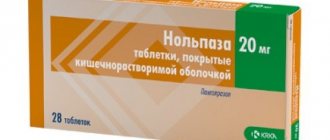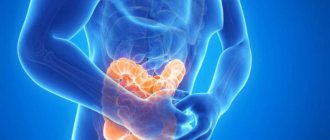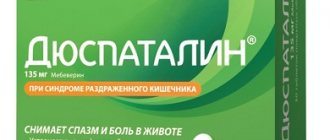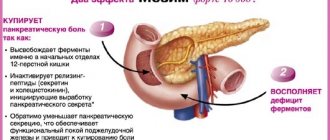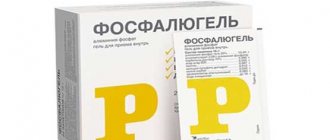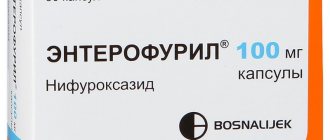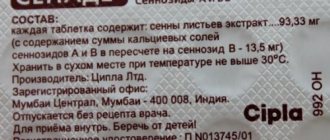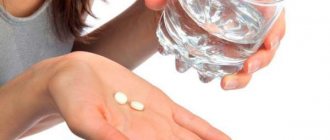To reduce the unpleasant conditions of the stomach and digestive system that arise as a result of increased acidity, it is recommended to use products with an antacid effect. Gaviscon is one of these. The product neutralizes hydrochloric acid and also reduces the acidity of gastric juice. How to take Gaviscon for the treatment of gastrointestinal tract? Can the medicine be used by children?
Gaviscon is a drug from the alginate group. The active components enter into physical interaction with gastric juice and form a dense gel-like barrier that is not absorbed and remains on the surface of the gastric contents.
Description and release form
There are several types of Gaviscon:
- Suspension for oral administration . A viscous substance of white or slightly cream color. The smell is menthol. Packaged in glass bottles of 100, 150 and 300 ml. The lid has a first opening control. Ingredients: sodium alginate and bicarbonate, calcium bicarbonate. Auxiliary components: carbomer, saccharinate and sodium hydroxide, peppermint oil, purified water, propyl parahydroxybenzoate, methyl parahydroxybenzoate.
- Suspension Gaviscon forte (mint) . 10 ml of the substance contains 1000 mg of sodium alginate, 200 mg of potassium bicarbonate. Packaged in bottles of 80, 150, 250 ml.
- Chewable tablets are round, flat-shaped, and have beveled edges. On one side of the tablet you can see a sword in a circle, and on the second side there is a number G. White tablets have a mint or lemon smell. Ingredients: sodium alginate (0.25 g), sodium bicarbonate (0.13 g), calcium carbonate (0.08 g). Additional components: macrogol, mennitol, magnesium stearate, aspartame, mint or lemon flavor, acesulfame potassium, copovidone. Mint tablets are packaged in blisters of 4, 6, 8 or 10 pieces. A cardboard package can contain from one to four blisters. The drug is also packaged in polypropylene containers (10 and 20 pieces each). One package contains two containers. Lemon tablets are sold in blisters of 8 pieces.
- Gaviscon Double Action . The substance in the form of a suspension is packaged in 10 ml bags and 150, 200, 300, 600 ml bottles. Also available in chewable tablet form.
Gaviscon is available in the form of tablets and suspensions.
special instructions
10 ml of suspension contains 141 mg (6.2 mmol) sodium. This should be taken into account if it is necessary to follow a diet with limited salt content (for congestive heart failure, for impaired renal function).
If there is no improvement within 7 days, a doctor's consultation is necessary.
Impact on the ability to drive vehicles and operate machinery
There is no effect on the ability to drive vehicles or operate machinery.
Action
After taking the drug orally, a gel forms in the stomach. The alginate substance reduces the acidic environment of the stomach by neutralizing the hydrogen ions of hydrochloric acid. In this case, the reaction of the gel that has formed remains neutral. It covers the surface of the gastric mucosa with a thin film, which is aimed at protecting against the harmful effects of acid and chemical compounds. In this case, the film stops the process of reflux of stomach contents into the lower parts of the esophagus. If gastroesophageal reflux occurs, the gel will reliably protect the esophagus from damage.
The active substances of the drug Gaviscon practically do not penetrate into the systemic bloodstream, but act directly on the stomach cavity and esophagus.
About the drug
Gaviscon - reduces the acidity of gastric juice.
Sodium alginate and other components of Gaviscon, entering the stomach, interact with the acidic environment inside this organ. As a result of this reaction, a gel with a neutral acid-base balance is formed.
It forms a kind of protective barrier on the irritated surface of the mucous membrane, completely eliminating the negative manifestations of reflux - esophagitis.
This protective film prevents regurgitation - the reflux of acidic contents back into the esophagus due to peristalsis of the stomach muscles.
Even if this process does occur, it is not acidic gastric juice that enters the esophagus, but a gel that does not cause irritation at all. Heartburn, which previously occurred as a result of backflow, does not appear after using Gaviscon. A distinctive feature of Gaviscon is that its action does not reduce the acidity of gastric juice, but protects the mucous membrane from excessive acid exposure through the formation of a gel.
This medicine is a symptomatic remedy. It does not treat diseases that cause heartburn, but relieves the unpleasant symptoms that accompany them. Its mechanism of action is a physical process that does not increase the concentration of drug components in the bloodstream.
Indications for use
Gaviscon tablets or suspensions are recommended to be taken for the following conditions and diseases:
- Dyspepsia;
- Feeling of heaviness in the upper parts of the stomach;
- Heartburn;
- Sour belching that occurs due to alcohol consumption, fatty, fried and spicy foods;
- Feelings of heaviness after eating.
Many doctors include the drug in the complex treatment of gastric ulcers and hyperacid gastritis. The drug helps to remove the unpleasant symptoms that are often observed when the acidity of gastric juice increases, which occurs against the background of functional disorders of the digestive system.
Gaviscon is used for the symptomatic treatment of the following conditions - dyspepsia associated with gastroesophageal reflux, hyperacidity, heartburn in pregnant women, after surgery on the esophagus.
Doctors recommend using Gaviscon during pregnancy, since neither the main substance nor the auxiliary components affect the health and development of the fetus.
Important! Only the attending physician can recommend treatment tactics for the problem and disease. Therefore, before using this drug, it is necessary to undergo examination and consult a specialist.
Gaviscon for heartburn: help for the expectant mother
Due to hormonal changes in the body and the growing uterus, expectant mothers often experience heartburn.
This condition cannot be tolerated: hydrochloric acid, acting on the mucous membrane, can lead to erosions and ulcers. For stomach discomfort, doctors recommend antacids, which include Gaviscon.
This drug is approved during pregnancy, but when using it you need to be aware of some features.
Action of Gaviscon
Gaviscon is prescribed to eliminate the following symptoms of digestive disorders:
- heartburn;
- sour belching;
- heaviness in the stomach.
Such conditions appear during pregnancy not only due to poor nutrition, but also due to physiological characteristics:
- after conception, the body produces the hormone progesterone, which has a relaxing effect on the muscles, including the cardiac sphincter, located between the esophagus and stomach;
- in the second half of pregnancy, the uterus begins to grow rapidly and put pressure on the internal organs, causing discomfort.
Heartburn does not in any way affect the development of the child in the womb, but it causes discomfort to the expectant mother.
Gaviscon, being an antacid, reduces the acidity of gastric juice, reduces irritation of the esophageal mucosa and quickly alleviates the condition.
Is it possible to take Gaviscon during pregnancy (including in the early stages)
According to the instructions, the drug is not absorbed into the blood and does not have a negative effect on the development of the fetus. It can be prescribed in any trimester.
There is an opinion that in the early stages the drug helps alleviate the symptoms of toxicosis. In fact, the medicine has no effect on the causes of this condition, so it cannot be used to get rid of nausea.
Release form: chewable tablets, suspension
The drug is produced in the form of chewable tablets and suspension for oral administration. The suspension is available in bottles and sachets of 10 ml, designed for a single dose. Both forms are equally effective.
Gaviscon is sometimes confused with the related drug Hexinon, which is used to treat thrush and is available in the form of suppositories. Gaviscon does not have such a dosage form.
Varieties of the drug: Gaviscon Forte and Double action
Types of Gaviscon differ in the active substance and its amount, but all of them are allowed during pregnancy.
Gaviscon and other medications should be taken at intervals of at least 2 hours. It is especially important to adhere to this rule when using antipsychotics, drugs containing iron, beta-blockers and histamine H2 receptor blockers.
Gaviscon is prescribed to relieve symptoms of heartburn, sour belching, and stomach dyspepsia. Gaviscon Forte is convenient during pregnancy: one of the release forms is sachets designed for a single dose, so the suspension is convenient to take anywhere Gaviscon Double action has a high calcium content
Gaviscon has a number of contraindications:
- individual intolerance to the components included in the composition;
- excess sodium or calcium in the body;
- urolithiasis disease;
- renal failure.
Side effects listed in the instructions include:
- allergic reactions;
- bronchospasm;
- bloating (occurs with an overdose).
The US Food and Drug Administration (FDA) has classified Gaviscon as Category A. This means that clinical studies have shown no adverse effects on the fetus in the first trimester of pregnancy, but no data are provided on the risk in the second and third trimesters.
If a pregnant woman has contraindications for prescribing Gaviscon, the doctor may recommend another antacid drug.
During pregnancy, all medications, even those that are approved for expectant mothers, should be taken only as prescribed by a doctor.
Chewable tablets Rennie effectively relieve heartburn and stomach dyspepsia Maalox is recommended to be taken in small courses - the doctor individually selects the duration of treatment Gastal does not have a systemic effect, but it can only be used when the benefit to the mother outweighs the risk to the fetus
Most pregnant women know from their own experience what heartburn is. You cannot treat this condition on your own, just as you cannot tolerate it. In this case, the only right decision would be to consult a doctor who will prescribe a safe antacid drug.
- Maria Demidchenko
Source: https://moy-kroha.info/geviskon-pri-izzhoge-pomoshh-budushhej-mame
Contraindications and side effects
There are a number of conditions for which the drug should not be taken. The Gaviscon instructions indicate the following contraindications:
- Individual sensitivity to components;
- Age up to 6 years;
- Phenylketonuria.
With caution and only on the recommendation of a doctor, you can take the drug for the following diseases:
- Cardiovascular failure.
- Malfunction of the kidneys. This problem requires a salt-free diet, and the drug contains a large amount of sodium
- Hepatic stone disease.
- High levels of calcium in the blood.
In most cases, Gaviscon is well tolerated and most often no problems occur during treatment. Only sometimes the use of the drug causes the following side effects in the form of an allergic reaction of the skin (rash, hives, swelling). But such manifestations as Quincke's edema and anaphylactic shock were not recorded throughout the studies. An overdose may result in bloating.
Important! If an allergy to a substance occurs, it is recommended to stop taking it. In case of overdose, you need to take sorbent substances.
Synonyms of nosological groups
| Category ICD-10 | Synonyms of diseases according to ICD-10 |
| K21 Gastroesophageal reflux | Biliary reflux esophagitis |
| Gastroesophageal reflux disease | |
| Gastrocardiac syndrome | |
| Gastroesophageal reflux disease | |
| Gastroesophageal reflux | |
| Nonerosive reflux disease | |
| Gastrocardiac syndrome | |
| Roemheld syndrome | |
| Erosive reflux esophagitis | |
| Ulcerative reflux esophagitis | |
| K30 Dyspepsia | Fermentative dyspepsia |
| Hyperacid dyspepsia | |
| Putrid dyspepsia | |
| Dyspepsia | |
| Dyspepsia | |
| Dyspepsia of nervous origin | |
| Dyspepsia in pregnant women | |
| Fermentative dyspepsia | |
| Putrefactive dyspepsia | |
| Drug-induced dyspepsia | |
| Dyspepsia caused by diseases of the gastrointestinal tract | |
| Dyspepsia caused by impaired gastrointestinal motility | |
| Dyspepsia caused by unusual foods or overeating | |
| Dyspeptic symptoms during pregnancy | |
| Dyspeptic syndrome | |
| Dyspeptic disorder | |
| Gastric dyspepsia | |
| Delayed gastric emptying | |
| Slow digestion | |
| Idiopathic dyspepsia | |
| Acid dyspepsia | |
| Upper gastrointestinal motility disorder | |
| Indigestion | |
| Nervous dyspepsia | |
| Non-ulcer dyspepsia | |
| Feeling of heaviness in the stomach after eating | |
| Postprandial functional dyspepsia | |
| Fermentation processes in the intestines | |
| Stomach upsets | |
| Gastrointestinal disorders | |
| Digestive disorders | |
| Gastrointestinal disorders | |
| Stomach upset | |
| Digestive disorder | |
| Digestive disorders in infants | |
| Symptoms of dyspepsia | |
| Putrid dyspepsia syndrome | |
| Putrefactive dyspepsia syndrome in young children | |
| Digestive insufficiency syndrome | |
| Non-ulcer dyspepsia syndrome | |
| Toxic dyspepsia | |
| Functional dyspepsia | |
| Functional digestive disorders | |
| Chronic dyspepsia | |
| Chronic episodes of dyspepsia | |
| Essential dyspepsia | |
| K31.8.2* Hyperacidity of gastric juice | Hyperacid dyspepsia |
| Hyperacid state | |
| Hyperacid conditions | |
| Hyperacidosis | |
| Hypersecretion of gastric juice | |
| Pathological hypersecretion | |
| Increased acidity | |
| Increased acidity of gastric juice | |
| Increased secretion of gastric juice | |
| Increased acid formation | |
| O26.8 Other specified conditions associated with pregnancy | Abnormal course of pregnancy |
| Perverted appetite in pregnant women | |
| Asthenia of pregnant women | |
| Vaginal discharge during pregnancy | |
| Constipation during and after pregnancy | |
| Constipation in pregnant women | |
| Heartburn during pregnancy | |
| Fever during pregnancy | |
| Nephropathy in pregnant women | |
| Early toxicosis of pregnancy | |
| Toxicosis of pregnancy | |
| Toxicosis of pregnant women | |
| Early toxicosis of pregnancy | |
| R10.1 Pain localized in the upper abdomen | Pain syndrome in acute pancreatitis |
| Pain syndrome with pancreatitis | |
| Pain in the stomach area | |
| Stomach pain | |
| Pain in the stomach | |
| Pain in the epigastric region | |
| Epigastric pain | |
| Pain in the upper abdomen | |
| Pain in the epigastric region | |
| Pain with acute gastritis with high acidity | |
| Pain in chronic gastritis with high acidity | |
| Gastralgia | |
| Discomfort and pain in the epigastric region | |
| Discomfort and pain in the epigastrium | |
| Gastric discomfort | |
| Epigastric pain | |
| Feeling of discomfort in the epigastric region | |
| Heaviness in the epigastric region | |
| Epigastric pain | |
| R14 Flatulence and related conditions | Bloating |
| Bloating | |
| Severe flatulence | |
| Gases in the postoperative period | |
| Degassing of the intestines before diagnostic studies | |
| Degassing of the intestines before x-ray examination | |
| Gas retention | |
| Excessive formation and accumulation of gases in the gastrointestinal tract | |
| Sour belching | |
| Flatulence | |
| Flatulence with increased gas formation in the gastrointestinal tract | |
| Flatulence in infants | |
| Flatulence in newborns | |
| Flatulence caused by fatty or unusual foods | |
| Flatulence caused by diseases of the gastrointestinal tract | |
| Belching | |
| Feeling bloated | |
| Feeling of fullness in the stomach | |
| Increased gas formation | |
| Increased gas formation in the gastrointestinal tract | |
| Increased formation and accumulation of gases in the gastrointestinal tract | |
| Increased gas formation and accumulation of gases in the gastrointestinal tract | |
| Feeling of fullness in the epigastrium | |
| Feeling of fullness in the stomach | |
| Feeling of heaviness in the stomach |
symptomatic treatment of dyspepsia associated with increased acidity of gastric juice and gastroesophageal reflux (heartburn, sour belching);
feeling of heaviness in the stomach after eating, incl. during pregnancy.
hypersensitivity to the components of the drug;
At a temperature of 15–30 °C.
2 years.
- hypersensitivity to any of the components of the drug;
- children's age up to 12 years.
Treatment of symptoms of gastroesophageal reflux, such as sour belching, heartburn, dyspepsia (indigestion, feeling of heaviness in the stomach) that occurs after eating, in patients with gastroesophageal reflux or during pregnancy.
https://www.youtube.com/watch?v=ytaboutru
hypersensitivity to any of the components of the drug;
phenylketonuria (see “Special instructions”);
With caution: if you have the following diseases or conditions, you should consult your doctor before using the drug: hypercalcemia, nephrocalcinosis and urolithiasis with the formation of calcium oxalate stones, congestive heart failure, renal dysfunction.
2 years.
Features of use
You should read the instructions before using Gaviscon (suspension or tablets). Some features need to be taken into account:
- The drug contains calcium and sodium, which means it is important to control the level of minerals in the blood, especially for people with sodium and calcium metabolism disorders.
- If symptoms do not go away a week after starting treatment, then you need to undergo additional examination to find out the reasons for the dysfunction of the stomach.
- Aspartame, which is part of Gaviscon tablets, can increase the formation of ketone bodies. Therefore, the medicine should not be used by people with phenylketonuria.
- Approved for use by patients with diabetes.
- The medicine does not affect attention or the speed of psychomotor reactions.
- It is necessary to understand that the drug relieves symptoms, but does not affect the root cause of digestive system disorders.
Gaviscon price, where to buy
The cost ranges from 104 - 147 rubles. for 16 tablets up to 213 rub. per pack of 32 pieces. In Moscow, the price of Gaviscon is 32 pcs. is 170 rubles.
Heartburn tablets Gaviscon Double Action in Moscow cost 146 rubles. 16 tablets.
- Online pharmacies in RussiaRussia
- Online pharmacies in KazakhstanKazakhstan
ZdravCity
- Gaviscon Double Action Susp.
for internal approx. mint 10ml 12 pcs. Reckitt Benckiser Healthcare International Ltd. RUR 249 order - Gaviscon Susp. for internal approx. mint 150mlReckitt Benckiser Healthcare (UK) Limited
206 rub. order
- Gaviscon Susp. for internal approx. mint 300mlReckitt Benckiser Healthcare (UK) Limited
RUB 354 order
- Gaviscon Forte Susp. for internal approx. when we take it. mint 10ml 12 pcs. Reckitt Benckiser Healthcare International Ltd
RUR 318 order
- Gaviscon double action chewable tablets. mint 24 pcs. Reckitt Benckiser Healthcare Limited
RUB 284 order
Pharmacy Dialogue
- Gaviscon chewable tablets No. 48 MintReckitt Benckiser
452 rub. order
- Gaviscon double action chewable tablets No. 24 MintReckitt Benckiser
RUB 335 order
- Gaviscon double action suspension sachet 10ml No. 12Reckitt Benckiser
RUB 307 order
- Gaviscon forte (pack of 10 ml No. 12 mint (during pregnancy)) Reckitt Benckiser
RUR 364 order
- Gaviscon (suspended mint flask 150ml) Reckitt Benckiser
RUB 202 order
Europharm* 4% discount using promo code medside11
- Gaviscon double action mint suspension 300 mlReckitt Benckiser Healthcare
RUR 398 order
- Gaviscon mint suspension 150 mlReckitt Benckiser Healthcare International
RUB 247 order
- Gaviscon chewable mint tablets n48 Reckitt Benckiser Healthcare (UK)
550 rub. order
- Gaviscon mint suspension 300 mlReckitt Benckiser Healthcare (Velikob
430 rub. order
- Gaviscon double action mint suspension 150 mlReckitt Benckiser Healthcare International Ltd
172 RUR order
show more
Dosage of tablets, suspension and powder
Powder . The instructions for use of Gaviscon Forte state that before using the drug, you must thoroughly knead the sachet so that the contents are thoroughly mixed. Adults are recommended to take 5-10 ml of the drug, but not more than 40 ml per day. Gaviscon Double Action suspension is taken 10-20 ml (after meals and also before bedtime). Allowed to take no more than 80 ml per day (4 doses).
Pills . The instructions for use of Gaviscon Double Action contain the following dosage: from 2 to 4 tablets at a time. The amount of medicine depends on the complexity of the disease. In this case, the maximum quantity cannot exceed 16 pieces. Tablets for oral use must be chewed thoroughly.
When taking the drug, you must adhere to the instructions for use and doctor's recommendations.
Suspension . The drug should not be given to children under 6 years of age. It is better not to prescribe Gaviscon Forte before the age of 12. From the age of six, the suspension is prescribed in the amount of 5-10 suspensions. In this case, the dose of 40 ml of the substance should not be exceeded. The medicine Gaviscon Double action in tablets is selected by the doctor individually, based on the problem. A child over 12 years of age is prescribed the same dosage as an adult.
Important! The effect of the drug occurs within half an hour.
Gaviscon or Phosphalugel: which is better in the treatment of gastrointestinal disorders
It is important to know! Bad breath is often caused by parasites! To check if you have parasites, add 1 spoon to a glass of water... Read more
When treating gastrointestinal diseases, a gastroenterologist selects several medications, some of which may be similar in pharmacological action or indications, and may also act as analogues of more expensive medications. Therefore, the question often arises about which is better – Gaviscon or Phosphalugel. They are compared in several ways.
Active substance
The most important characteristic of each drug is its active ingredients. To decide which is better - Phosphalugel or Gaviscon, you should compare their compositions.
Active ingredients of Gaviscon: sodium alginate, sodium bicarbonate, calcium carbonate. Available in the form of tablets, mint suspension, and also in Forte form, which contains double the amount of active ingredients and does not contain sodium bicarbonate.
Phosphalugel contains aluminum phosphate as an active ingredient. Available in oral gel, sachet or bottle form.
Mechanism of action
According to the pharmacotherapeutic classification, these are drugs from different groups, but with similar effects. Gaviscon belongs to a group of drugs intended for the treatment of peptic ulcers and gastroesophageal reflux (GERD). Phosphalugel is classified as a drug prescribed for acid-dependent pathologies of the stomach, antacids based on aluminum phosphate.
Gaviscon
Once in the stomach, the suspension interacts with gastric juice. As a result, a layer of alginic acid is formed on the mucous membranes. The acidity of the formed layer is close to neutral values. For four hours, the walls of the stomach remain covered with this layer.
Phosphalugel
Aluminum phosphate, like other antacids, due to its buffering properties, is able to neutralize excess hydrochloric acid, while maintaining physiological conditions for food digestion. Does not cause a rebound effect - secondary hypersecretion of gastric juice.
The resulting micelles of the drug envelop the mucous membranes, protecting them from the harmful effects of an aggressive environment. Promotes regeneration of mucous membranes. Mucus secretion increases, as the drug enhances the synthesis of prostaglandins.
Indications for use
Despite the similarity of pharmacological effects, the indications of the drugs also differ. This allows you to choose which is better between Phosphalugel and Gaviscon for a particular disease.
Gaviscon
The drug has a limited number of indications. It is prescribed to relieve symptoms of gastroesophageal reflux and heartburn.
Phosphalugel
The drug is used both as monotherapy and as part of complex treatment regimens for diseases of the stomach and intestines. These include: stomach and intestinal ulcers, gastritis, hiatal hernia, reflux esophagitis.
Prescribed for functional diarrhea and dyspepsia, gastrointestinal disorders resulting from poisoning, infections, and the use of irritating compounds. Also indicated for discomfort and flatulence, belching, heartburn, abdominal pain, if they are not caused by appendicitis or other emergency conditions.
Contraindications
The different compositions of the drugs being compared also determine different limitations in their use in the treatment of different groups of patients.
A contraindication to the use of Gaviscon is a known or suspected allergic reaction to the active substances or auxiliary components. In addition, patients are often allergic to methyl and propyl parahydroxybenzoates.
Phosphalugel should not be used by patients who have a medical history of episodes of hypersensitivity to aluminum phosphate or other components of the drug. It is forbidden to use Phosphalugel for severe abdominal pain unless the cause has been established by a physician. The drug is contraindicated in chronic diarrhea, constipation, and Alzheimer's disease.
Instructions for use
Gaviscon
Children over twelve years of age and adults are prescribed two to four teaspoons of the drug orally after meals and before bed. No dosage adjustment is required for elderly patients. A child over six years old is prescribed one to two teaspoons after meals.
Phosphalugel
Shake the bottle of gel and crush the sachet with your fingers to obtain a homogeneous structure. Can be used pure or mixed in one hundred milliliters of water.
Adults are prescribed up to two packets one to three times a day. The maximum number of sachets per day should not exceed six. Children under six months - no more than one teaspoon after each feeding. From six months - no more than two teaspoons.
For diaphragmatic hernia, gastroesophageal reflux, gastrointestinal reflux, the drug is taken after meals and before bedtime. For peptic ulcers - only a few hours after eating and when pain occurs. For gastritis and dyspepsia - before meals. For functional diarrhea - morning and evening.
The duration of treatment should not exceed two weeks.
Adverse reactions
For ease of comparison of undesirable symptoms, they are presented in table form for two drugs at once.
| Organ System/Drug | Gaviscon | Phosphalugel |
| Digestive tract | Bloating, constipation | Constipation, mainly in elderly and bedridden patients |
| Mediastinum, respiratory system | Bronchospasm | |
| The immune system | Anaphylactic reactions, urticaria, skin rashes | Allergy with individual hypersensitivity |
If undesirable symptoms are detected, you should contact your doctor to select a different drug or adjust the dosage.
special instructions
Application features often become the decisive factor for patients and gastroenterologists choosing Gaviscon or Phosphalugel.
Gaviscon
If improvements do not occur within a week, the advisability of treatment with Gaviscon should be reconsidered. Patients following a low-salt diet should note that the drug contains sodium.
Caution should be exercised in case of nephrocalcinosis, hypercalcemia, as well as progressive calcium stones in the kidneys. Patients with kidney disease should constantly monitor the levels of calcium, magnesium and calcium in the blood.
The drug does not affect pregnancy and breastfeeding, but during these periods it is recommended to use it only after consultation with your doctor.
Phosphalugel
Since aluminum phosphate reduces the level of phosphorus in the blood serum, it is not recommended to use Phosphalugel in chronic renal failure. If the symptoms of the disease do not disappear within a week, consultation with a gastroenterologist is required.
If abdominal pain occurs in combination with fever and vomiting, urgent medical attention is required.
The medicine contains sorbitol, so it should not be used to treat patients with fructose intolerance. Studies on the effect during pregnancy allow the use of Phosphalugel in the third trimester for a short period.
What is better between Gaviscon and Phosphalugel
By comparing two well-known drugs according to their main characteristics, a generalized comparison can be made between them. To eliminate heartburn and belching that are not associated with severe diseases of the stomach and intestines, Gaviscon is ideal. It will also help pregnant women out if the functioning of the gastrointestinal tract is disrupted as a result of hormonal changes.
https://www.youtube.com/watch?v=TXDLBAjr9RU
Gaviscon is one of the few drugs approved for use during pregnancy and breastfeeding.
Phosphalugel is a drug with a wider spectrum of action in relation to the correction of gastrointestinal conditions. It is actively used to eliminate the symptoms of ulcers, gastritis, reflux esophagitis, and therefore claims to be more widely used among patients. Phosphalugel is not recommended during pregnancy and lactation.
General characteristics
In view of the comparison, there is quite little in common between the drugs. The only thing that generalizes them is their effectiveness in relation to the symptoms of diseases of the digestive tract. But they eliminate these symptoms in different ways, so this property is only indirectly common.
Tips from our readers
I got rid of parasites in just a week! I was helped by a remedy that I learned about from an interview with a parasitologist...
Read the expert's opinion >>
Reviews about the drugs
“During pregnancy, I suffered from heartburn no matter what I ate. Gaviscon alone saved the day, although the effect was short-lived, but at least there was some effect. And the taste is not pleasant.”
Evgenia, Moscow
“In the complex, Gaviscon treats, but now even children are diagnosed with gerb, they have to buy a lot of medicines, and you can’t immediately tell whether everything together helped, or just one thing. The price is not the lowest."
Albina, Ufa
“I drank Phosphalugel for the first time when I had food poisoning, then I finished it when I had heartburn, and I bought it again recently - it’s not economical, but it’s effective. The advantage is that you can take the bags with you to work, in case heartburn starts there.”
Galina, Kaluga
“I gave Phosphalugel to a child with an intestinal infection, naturally, in combination with other drugs prescribed by the doctor. There is an effect. Later I tested it on myself when my stomach hurt after taking painkillers.”
Svetlana, Yaroslavl
Source: https://GastrituNet.online/lekarstva/antatsidy/fosfalyugel/geviskon-ili-fosfalyugel-chto-luchshe.html
Gaviscon's analogs
There are currently no drugs that have the same active ingredients. But at the pharmacy you can always buy analogues with an antacid effect, the instructions for use of which contain the same indications. These drugs include:
- Almagel;
- Alfogel;
- Alumag;
- Aktal;
- Becarbon;
- Gastrik;
- Gasterin;
- Gastal;
- Maalox;
- Magnesium oxide;
- Rennie;
- Riofast;
- Scorolight;
- Talcid;
- Rivolox;
- Phosphalugel;
- Tisacid.
Important! Before using substitute drugs, you should consult a specialist. He will be able to suggest what is best for the patient in each specific case.
Compound
| Chewable mint tablets | 1 table |
| active substances: | |
| sodium alginate | 250 mg |
| sodium bicarbonate | 133.5 mg |
| calcium carbonate | 80 mg |
| excipients: mannitol - 255 mg; macrogol 20000 - 30 mg; magnesium stearate - 4 mg; aspartame - 3.75 mg; copovidone - 28 mg; acesulfame potassium - 3.75 mg; mint flavor - 12 mg |
| Suspension for oral administration (mint) | 10 ml |
| active substances: | |
| sodium alginate | 500 mg |
| sodium bicarbonate | 213 mg |
| calcium carbonate | 325 mg |
| excipients: carbomer (974P) - 65 mg; methyl parahydroxybenzoate - 40 mg; propyl parahydroxybenzoate - 6 mg; sodium hydroxide - 26.67 mg; sodium saccharinate - 10 mg; mint flavor - 6 mg; water (purified) - up to 10 ml |
active ingredients: sodium alginate 500 mg, sodium bicarbonate 267 mg, calcium carbonate 160 mg;
excipients: carbomer 65 mg, methyl parahydroxybenzoate 40 mg, propyl parahydroxybenzoate 6 mg, sodium saccharinate 10 mg, peppermint oil 1 mg, sodium hydroxide 26.667 mg, purified water up to 10 ml.
| Oral suspension | 10 ml |
| active substances: | |
| sodium alginate | 1000 mg |
| potassium bicarbonate | 200 mg |
| Excipients | |
| oral suspension (anise): calcium carbonate - 200 mg; carbomer - 40 mg; methyl parahydroxybenzoate - 40 mg; propyl parahydroxybenzoate - 6 mg; sodium hydroxide - 14.44 mg; sodium saccharinate - 10 mg; fennel flavor - 7 mg; purified water - up to 10 ml | |
| oral suspension (mint): calcium carbonate - 200 mg; carbomer - 40 mg; methyl parahydroxybenzoate - 40 mg; propyl parahydroxybenzoate - 6 mg; sodium hydrogen oxide - 14.44 mg; sodium saccharinate - 10 mg; mint flavor - 6 mg; purified water - up to 10 ml |
active ingredients: sodium alginate 1000 mg, potassium bicarbonate 200 mg;
oral suspension [anise]: calcium carbonate 200 mg, carbomer 40 mg, methyl parahydroxybenzoate 40 mg, propyl parahydroxybenzoate 6 mg, sodium hydroxide 14.44 mg, sodium saccharinate 10 mg, fennel flavor 7 mg, purified water up to 10 ml;
oral suspension [mint]: calcium carbonate 200 mg, carbomer 40 mg, methyl parahydroxybenzoate 40 mg, propyl parahydroxybenzoate 6 mg, sodium hydroxide 14.44 mg, sodium saccharinate 10 mg, mint flavor 6 mg, purified water up to 10 ml.
Reviews
Thanks to the drug, patients who have problems with increased stomach acidity experience relief from all unpleasant symptoms within a week. Almost all reviews are positive. Only in a few cases did an allergic reaction occur. However, many doctors prescribe Gaviscon for pregnant women.
According to many people, it is better to use suspensions rather than tablets. This is due to the fact that the tablets do not always taste good, stick to the teeth, and also have a shorter therapeutic effect.
Clinical and pharmacological group: Antacid drug.
Pharmacotherapeutic group: Reflux esophagitis treatment.
Use during pregnancy and lactation
During clinical studies by pharmacists in gynecology regarding the effects of the components of the drug Gaviscon on the fetus, it was revealed that the drug and its metabolites do not pass the placental barrier and do not have any effects on the embryo either in the early stages of pregnancy or in a later period of gestation. The medication is approved by pediatricians during breastfeeding.
One of the few drugs with antacid action approved for use in
and during
, is Gaviscon. This is due to the fact that Gaviscon is not absorbed into the general bloodstream, but only creates a protective gel film in the stomach, protecting the mucous membrane of the stomach and esophagus from the effects of acidic gastric contents.
Clinical studies prove the absence of a negative effect of Gaviscon on the course of pregnancy and on the fetus.
